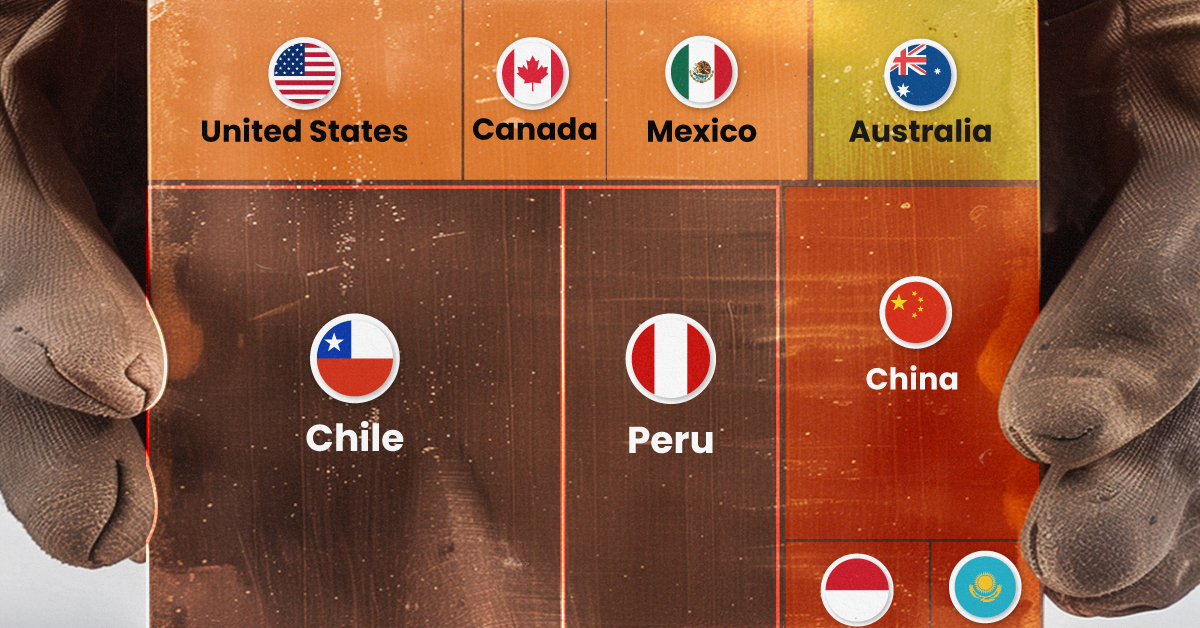Mining
The Gold Series: Unearthing the World’s Supply (Part 2 of 5)
The Gold Series Part 2: Unearthing the World’s Gold Supply
This infographic, part two in our 2014 Gold Series, covers the full supply picture behind the yellow metal.Within the planet’s crust, there is only 1 gram of gold for every 250 tonnes (550,000 lbs) of earth.
Gold’s rarity means that finding economic deposits is extremely difficult. To understand how gold mining and supply work, we must first unearth how deposits form.
Over time, gold dissolves in hot water deep in the crust under immense pressure. It is then transported and deposited upwards as the water travels up cracks and fissures towards the surface. Generally, the major deposit types include: placer, volcanogenic massive sulphide (VMS), epithermal, porphyry, carlin-type, and orogenic deposits.
Check out Part 3 of The 2014 Gold Series on rising demand in Asia.
Presented by: Goldcorp
Also made possible by: Falco Pacific, Balmoral Resources, Brazil Resources, Eastmain Resources, and Brixton Metals.
Mining
Visualizing Copper Production by Country in 2023
Chile and Peru account for one-third of the world’s copper output.

Visualizing Copper Production by Country in 2023
This was originally posted on our Voronoi app. Download the app for free on iOS or Android and discover incredible data-driven charts from a variety of trusted sources.
Copper is considered an essential metal for the clean energy transition because it is a great conductor of electricity.
As a result, governments around the world have been encouraging the construction of new mines, and mining companies have been seeking new projects and acquiring existing mines to meet the growing demand.
In this graphic, we illustrate global copper production in 2023, based on data from the U.S. Geological Survey, Mineral Commodity Summaries, as of January 2024.
Most Copper Comes from South America
Chile and Peru account for one-third of the world’s copper output.
| Country | Region | 2023E Production (Million tonnes) |
|---|---|---|
| 🇨🇱 Chile | South America | 5.0 |
| 🇵🇪 Peru | South America | 2.6 |
| 🇨🇩 Congo (Kinshasa) | Africa | 2.5 |
| 🇨🇳 China | Asia | 1.7 |
| 🇺🇸 United States | North America | 1.1 |
| 🇷🇺 Russia | Europe/Asia | 0.9 |
| 🇦🇺 Australia | Oceania | 0.8 |
| 🇮🇩 Indonesia | Asia | 0.8 |
| 🇿🇲 Zambia | Africa | 0.8 |
| 🇲🇽 Mexico | North America | 0.7 |
| 🇰🇿 Kazakhstan | Asia | 0.6 |
| 🇨🇦 Canada | North America | 0.5 |
| 🇵🇱 Poland | Europe | 0.4 |
| 🌍 Rest of World | -- | 3.1 |
| World total (rounded) | -- | 21.5 |
Chile is also home to the two largest mines in the world, Escondida and Collahuasi.
Meanwhile, African countries have rapidly increased their production. The Democratic Republic of Congo, for example, transitioned from being a secondary copper producer in the late 1990s to becoming the third-largest producer by 2023.
Part of the growth in copper mining in Africa is attributed to high investment from China. Chinese mining companies represent 8% of Africa’s total output in the mining sector.
Within its territory, China has also seen a 277% growth in copper production over the last three decades.
In the U.S., Arizona is the leading copper-producing state, accounting for approximately 70% of domestic output. Copper is also mined in Michigan, Missouri, Montana, Nevada, New Mexico, and Utah.
-

 Healthcare5 days ago
Healthcare5 days agoLife Expectancy by Region (1950-2050F)
-

 Economy2 weeks ago
Economy2 weeks agoRanked: The Top 20 Countries in Debt to China
-

 Politics2 weeks ago
Politics2 weeks agoCharted: Trust in Government Institutions by G7 Countries
-

 Energy2 weeks ago
Energy2 weeks agoMapped: The Age of Energy Projects in Interconnection Queues, by State
-

 Mining2 weeks ago
Mining2 weeks agoVisualizing Global Gold Production in 2023
-

 Markets1 week ago
Markets1 week agoVisualized: Interest Rate Forecasts for Advanced Economies
-

 Economy1 week ago
Economy1 week agoThe Most Valuable Companies in Major EU Economies
-

 Markets1 week ago
Markets1 week agoThe World’s Fastest Growing Emerging Markets (2024-2029 Forecast)


















